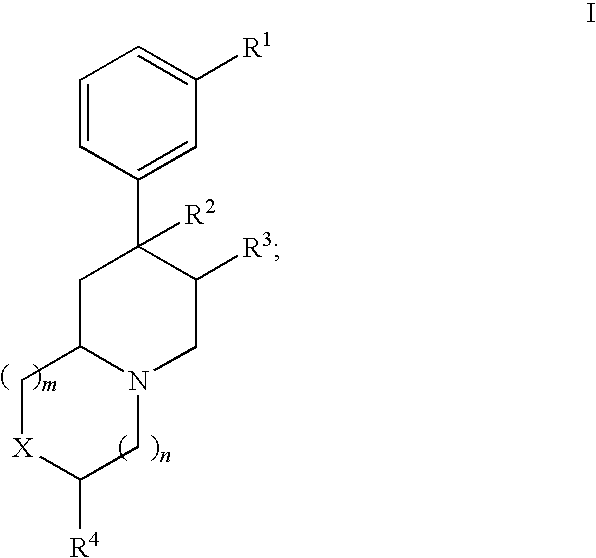Opioid antagonists
a technology of opioid agonists and antagonists, which is applied in the field of compounds, can solve problems such as side effects, intestinal dysfunction, and agonists of opioid agonists
- Summary
- Abstract
- Description
- Claims
- Application Information
AI Technical Summary
Benefits of technology
Problems solved by technology
Method used
Image
Examples
example 1
Preparation of 1.3:
[0711]To a stirred solution of 1.1 (30 g, 146 mmol) in tetrahydrofuran (150 mL) under nitrogen at 0° C., was added a solution of 1.2 (35 g, 160 mmol) and triethylamine (24.45 mL, 175 mmol) in tetrahydrofuran (150 mL) over 1 hour. The solution was stirred at room temperature for 18 hours. The reaction mixture was concentrated under reduced pressure and the residue dissolved in ethyl acetate (300 mL). The solution was then washed with 0.5M aqueous solution of hydrochloric acid (2×60 mL) and dried over sodium sulfate. The reaction mixture was concentrated under reduced pressure and used in the next step without further purification. Yield: 100% 1H NMR (400 MHz, CDCl3) δ: 0.64 (d, J=7 Hz, 3H), 1.35 (s, 3H), 1.47 (s, 9H),1.53 (m, 1H), 1.97 (br s, 1H), 2.19 (dt, J=13 Hz and 5 Hz, 1H), 3.05 (br s, 1H), 3.30 (br s, 1H), 3.82 (br s, 1H), 4.10 (br s, 0.5H), 4.24 (br s, 0.5H), 6.23 (br s, 1H), 6.68 (m, 1H), 6.78 (m, 2H), 7.17 (t,J=8 Hz 1H)
[0712]Mass Spectral Analysis, m / z ES...
example 2a
Preparation of 2.2:
[0735]To a solution of 1.2 (72.69 g, 238 mmol) in N,N-dimethylformamide (500 mL) was added imidazole (43.13 g, 309 mmol), N,N-dimethylaminopyridine (DMAP) (2.9 g, 23.8 mmol) and 2.1 (43.13 g, 286 mmol). The reaction mixture was stirred at room temperature for 16 hours. The reaction mixture was then poured into water and extracted with hexanes. The combined organic extracts were washed successively with water and brine solution, dried over sodium sulfate and concentrated under reduced pressure. The crude product was purified by column chromatography (eluent: hexane / ethyl acetate mixtures of increasing polarity). Yield: 86% 1H NMR (400 MHz, CDCl3) δ: 0.18 (s, 6H), 0.62 (d, J=6 Hz, 3H), 0.98 (s, 9H), 1.26 (s, 1H), 1.34 (s, 3H), 1.46 (s, 9H), 1.96 (m, 1H), 2.17 (m, 1H), 3.03 (m, 1H), 3.30 (m, 1H), 3.79 (m, 0.6H), 3.88 (m, 0.4H), 4.06 (m, 0.5H), 4.23 (m, 0.5H), 6.67 (dd, J=8 Hz and 2 Hz, 1H), 6.73 (s, 1H), 6.84 (d, J=7 Hz, 1H), 7.16 (t, J=8 Hz, 1H)
[0736]Mass Spectral A...
example 2b
Preparation of 2B:
[0745]To a solution of 2A (0.1 g, 0.26 mmol) in anhydrous tetrahydrofuran (10 mL) was added borane-dimethyl sulfide complex (2M solution in tetrahydrofuran, 0.4 mL, 0.8 mmol) and the reaction heated to reflux under a nitrogen atmosphere for 16 hours. The mixture was then cooled to 0° C. Methanol (5 mL) was added to the reaction mixture which was stirred at 0° C. for 1 hour. A 2M anhydrous solution of hydrogen chloride in diethyl ether (2.5 mL) was then added to the reaction mixture, which was then heated to reflux for 1 hour. The mixture was cooled to room temperature. Aqueous ammonium hydroxide solution (2.5 mL) was added to the mixture, which was stirred for 10 minutes at room temperature. The mixture was concentrated under reduced pressure. The residue was dissolved in methanol and the solution was concentrated under reduced pressure. This process was repeated 3 times. The crude product was purified by column chromatography (eluent: dichloromethane / methanol / ammo...
PUM
| Property | Measurement | Unit |
|---|---|---|
| weight | aaaaa | aaaaa |
| body weight | aaaaa | aaaaa |
| body weight | aaaaa | aaaaa |
Abstract
Description
Claims
Application Information
 Login to View More
Login to View More - R&D
- Intellectual Property
- Life Sciences
- Materials
- Tech Scout
- Unparalleled Data Quality
- Higher Quality Content
- 60% Fewer Hallucinations
Browse by: Latest US Patents, China's latest patents, Technical Efficacy Thesaurus, Application Domain, Technology Topic, Popular Technical Reports.
© 2025 PatSnap. All rights reserved.Legal|Privacy policy|Modern Slavery Act Transparency Statement|Sitemap|About US| Contact US: help@patsnap.com



